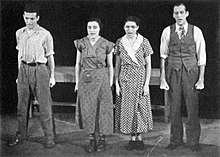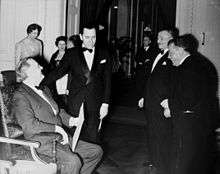Pins and Needles
Pins and Needles is a musical revue with a book by Arthur Arent, Marc Blitzstein, Emmanuel Eisenberg, Charles Friedman, David Gregory, Joseph Schrank, Arnold B. Horwitt, John Latouche, and Harold Rome, and music and lyrics by Rome. The title Pins and Needles was created by Max Danish, long-time editor of the International Ladies Garment Workers Union (ILGWU)'s newspaper Justice. It ran on Broadway from 1937 to 1940, was revived in 1978, and produced again in London in 2010 to positive reviews. In 2016, the show ran at the Provincetown Playhouse in New York City, where it was produced by the Steinhardt School at New York University.[1] The revue was also performed in 1938 in the White House for Franklin and Eleanor Roosevelt.[2][3]
| Pins and Needles | |
|---|---|
| Music | Harold Rome |
| Lyrics | Harold Rome |
| Book | Arthur Arent Marc Blitzstein Emmanuel Eisenberg Charles Friedman David Gregory Joseph Schrank Arnold B. Horwitt John Latouche Harold Rome |
| Productions | 1937 Broadway |
Background
The International Ladies Garment Workers Union used the Princess Theatre in New York City as a meeting hall. The union sponsored an inexpensive revue with ILGWU workers as the cast and two pianos. Because of their factory jobs, participants could rehearse only at night and on weekends, and initial performances were presented only on Friday and Saturday nights.[4][5] The original cast was made up of cutters, basters, and sewing machine operators.[6]
Pins and Needles looked at current events from a pro-union standpoint. It was a "lighthearted look at young workers in a changing society in the middle of America's most politically engaged city."[5] Skits spoofed everything from Fascist European dictators to bigots in the Daughters of the American Revolution. Word-of-mouth was so enthusiastically positive that the cast abandoned their day jobs and the production expanded to a full performance schedule of eight shows per week. New songs and skits were introduced every few months to keep the show topical.
According to John Kenrick, Pins and Needles "is the only hit ever produced by a labor union, and the only time when a group of unknown non-professionals brought a successful musical to Broadway."[4]
Productions


Originally written for a small theatrical production with music and lyrics by Harold Rome,[7] the first production of Pins and Needles was directed by Samuel Roland. After a two-week professional run, it was adapted for performances by members of the then-striking International Ladies Garment Workers' Union as an entertainment for its members. Because Roland was associated with left-wing causes, he was asked by ILGWU president David Dubinsky to withdraw. The better-known ILGWU production was directed by Charles Friedman and choreographed by Benjamin Zemach.[8] It opened on November 27, 1937 at the Labor Stage Theatre[9] and then transferred to the Windsor Theatre on June 26, 1939,[10] finally closing on June 22, 1940 after 1,108 performances.[11] The cast included Harry Clark. The production was directed by the African-American dancer Katherine Dunham.
The revue was performed in 1938 in the White House for Franklin and Eleanor Roosevelt.[2][3] Brooks Atkinson, perhaps the most important theater critic at the time, wrote that "Pins and Needles is a gay, satirical revue, which is amusing, as Mrs. Roosevelt knows, for she has recently sealed it with the cachet of the White House".[12][13]
When the musical was set to play in Providence, Rhode Island, in October 1940, The New York Times reported that the Providence Bureau of Police and Fire "ruled...that the musical hit 'Pins and Needles' cannot play in [Providence] until one of its scenes is deleted."[14] The scene in question satirized the anti-Jewish, pro-fascist Catholic priest Father Coughlin, the German American Bund leader Fritz Kuhn, and Democratic Party U.S. Senator from North Carolina Robert Reynolds. The New York Times reported that the management of the play ended up cutting the scene but under protest.[15]
The Roundabout Theatre Company produced a revival Off-Broadway at the Roundabout Stage 1 Theatre in 1978, which ran for 225 performances.[16][17][18]
The Jewish Repertory Theatre presented a concert in 2003, to include songs and sketches from all versions of the show.[19]
Pins and Needles was presented in the UK for the first time at the Cock Tavern Theatre in Kilburn, London in November and December 2010. The production was directed by Rachel Grunwald and received positive reviews from the theatre press.[20][21]
In 2011, an updated version of the show was performed at The Foundry Theatre, in Fort Greene, Brooklyn, by members of the social-justice organization "FUREE" (Families United For Racial and Economic Equality).
In 2016, Pins and Needles ran at the Provincetown Playhouse in New York City, where it was produced by the Steinhardt School at New York University.[1] The production was directed by Meg Bussert with orchestrations and musical supervision by Joe Church. The cast featured NYU students, who would have been around the same ages as the actors in the original production.
Songs
|
|
25th Anniversary recording
In commemoration of the show's 25th Anniversary, in May 1962, Columbia Records released a studio recording of the score featuring then-newcomer Barbra Streisand.[19] Columbia president Goddard Lieberson did not approve Streisand's involvement with this record until pressured by Harold Rome. She remained unsigned to Columbia until October 1, 1962. The recording was digitally restored and remastered for CD release.
Track listing
- "Sing Me A Song With Social Significance" [2:52]
- "Doing The Reactionary" [2:01]
- "One Big Union For Two" [2:57]
- "It's Better With A Union Man" [3:03]
- "Nobody Makes A Pass At Me" [4:17]
- "I've Got The Nerve To Be In Love" [4:46]
- "Not Cricket To Picket" [2:29]
- "Back To Work" [2:13]
- "Status Quo" [4:27]
- "When I Grow Up (The G-Man Song)" [2:49]
- "Chain Store Daisy" [3:50]
- "Four Little Angels Of Peace" [4:36]
- "Sunday In The Park" [3:31]
- "What Good Is Love" [3:38]
- "Mene, Mene, Tekel" [3:51]
Barbra Streisand vocals are featured on tracks 2 (Solo), 5 (Solo), 7 (Solo), 9 (Solo), 12 & 14.
References
- Pins and Needles local802afm.org
- Daniel Katz. All Together Different: Yiddish Socialists, Garment Workers, and the Labor Roots of Multi-Culturalism. New York: NYU Press, 2011.
- Susan Ware. "Skin Deep", a review of the book An Intimate Affair: Women, Lingerie, and Sexuality by Jill Fields, University of California Press, 2007. This review appeared in the Washington Post, Sunday, July 15, 2007.
- Kenrick, John."Pins and Needles" Musicals101.com, accessed July 28, 2010
- "Political Satire" pbs.org, accessed July 28, 2010
- "Cultural Initiatives" laborarts.org, accessed July 28, 2010
- "Mr. Rome of 'Pins and Needles'", New York Times, December 12, 1937, p. 194
- Kisselgoff, Anna. "Benjamin Zemach, 95, Dancer; Worked in Theater and Films" The New York Times, June 30, 1997
- "The Play: Pins and Needles", The New York Times, November 29, 1937, p. 18
- "Pins and Needles" moves to Windsor Tonight", The New York Times, June 26, 1939, p. 17.
- "'Pins and Needles' Ends Run Tonight: Sets a Record for Musicales With 1,108 Performances--Began Here Nov. 27, 1937", The New York Times, June 22, 1940, p. 18
- Atkinson, Brooks (March 13, 1938). "Standards in Drama Criticism; Mrs. Roosevelt's Dissatisfaction With the Comments on the Stage In This Newspaper and One Other". The New York Times. Retrieved 2017-12-15.
- See also, Louis Stark, "President Pledges Wide Aid to Labor", The New York Times, March 4, 1938, p. 8: "The New York cast of 'Pins and Needles,' sponsored by the International Ladies Garment Workers' Union, presented ten sketches from its musical revue. Earlier, the 'Pins and Needles' company appeared at the White House, performing part of its full show before the President, Mrs. Roosevelt and a few of their friends."
- "'Pins and Needles' Scene Banned", The New York Times, October 23, 1940, p. 27
- "Cut Skit From 'Pins and Needles'", The New York Times, October 24, 1940, p. 30
- "'Pins and Needles' listing, Off-Broadway" Internet Off-Broadway Database listing, accessed July 28, 2010
- See Tom Prideaux, "Tailor-Made Hit of the 30's: 'Pins and Needles,' put on by the ILGWU, first tickled the consciousnesses of audiences in 1937. Now the musical takes on a new generation", The New York Times, Sunday, June 4, 1978, Sunday magazine, p. 8
- Eder, Richard. " 'Pins and Needles,' Musical, Is Staged: The Cast" The New York Times, July 8, 1978
- Jones, Kenneth."Mason and Walton Sing Rome's Pins and Needles in NYC Concert, March 27-31" Playbill.com, March 27, 2003
- BWW News Desk."PINS and NEEDLES Plays The Cock Tavern Theater" westend.broadwayworld.com, November 4, 2010
- Lukowski, Andrzej."'Pins and Needles' Review" TimeOut.com, November 24, 2010
- "Sparkling Musical Revue" Life, December 27, 1937, pp. 52-53